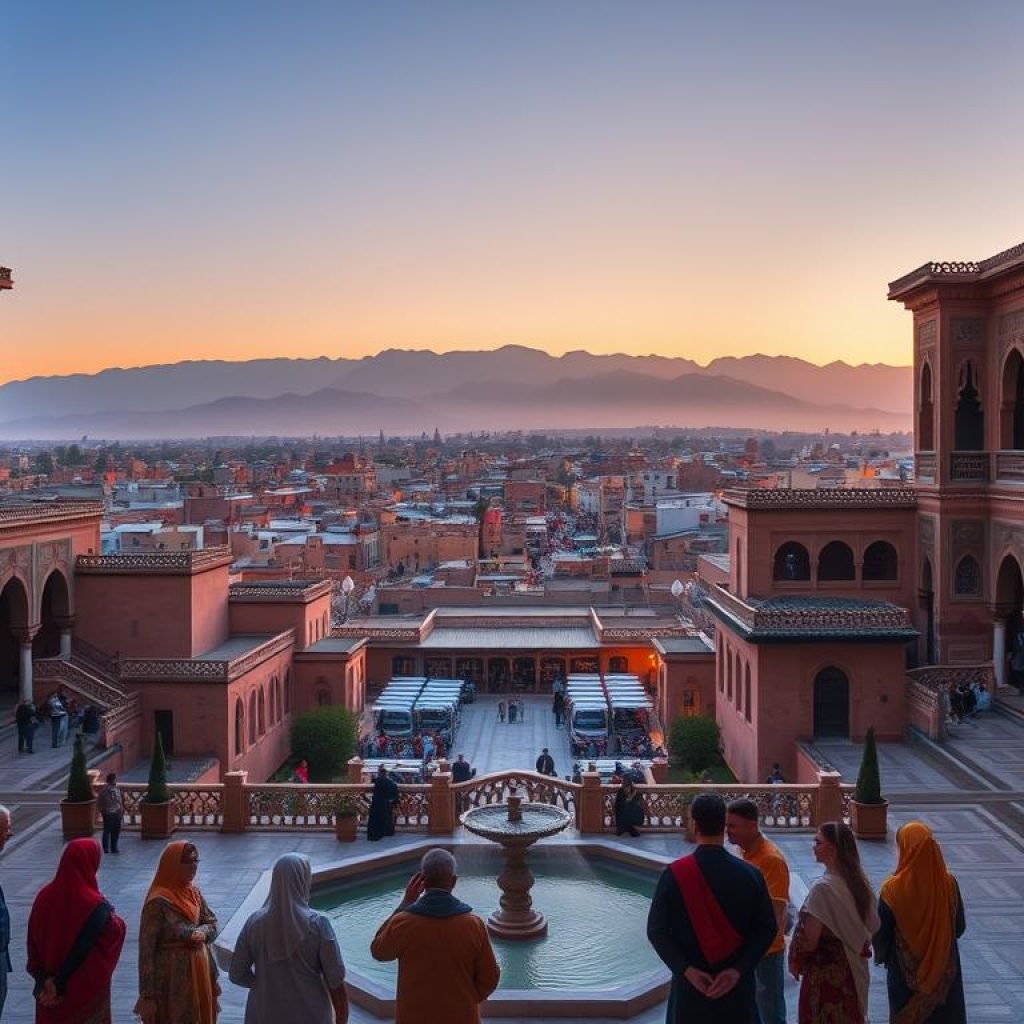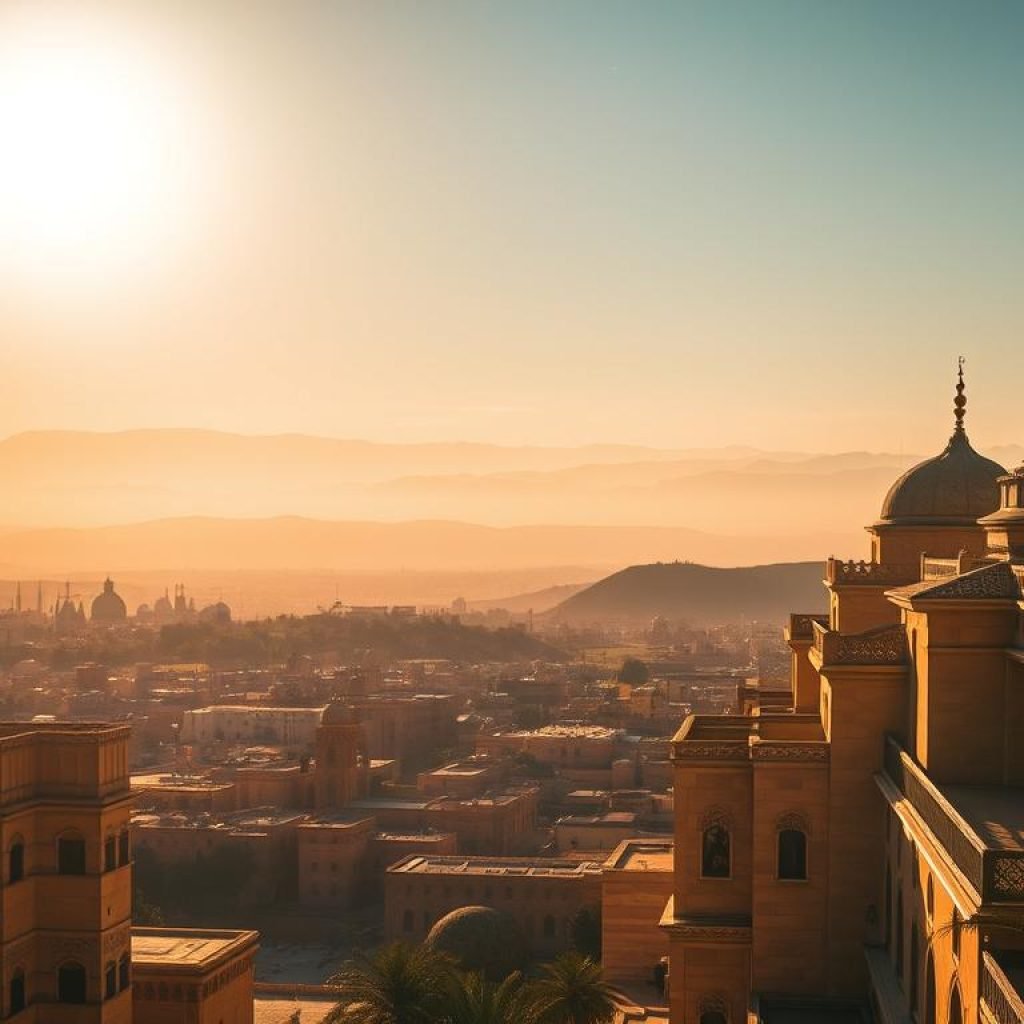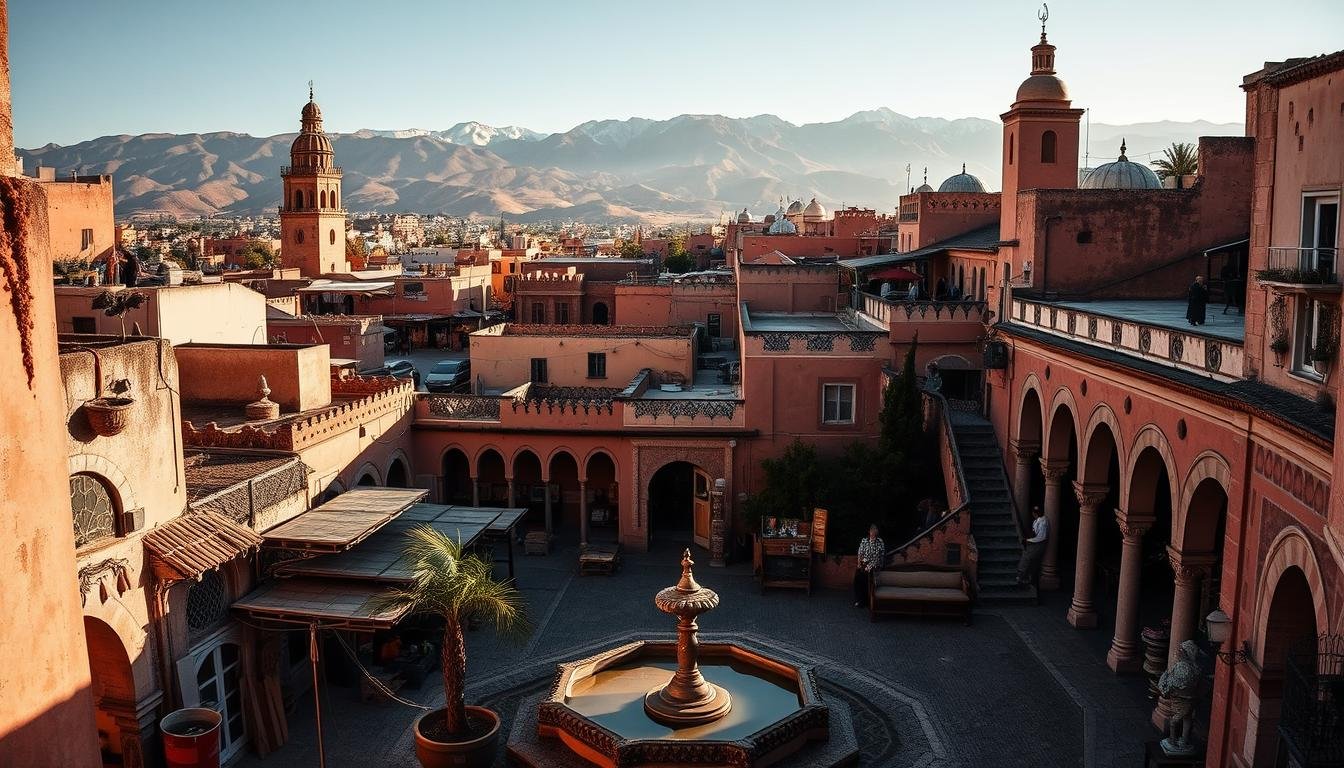Have you ever wondered what makes Morocco a gateway to Africa’s rich cultural tapestry? This vibrant country is a treasure trove of architectural marvels, blending Arab, Berber, and European influences into its iconic landmarks. From ancient medinas to grand palaces, each place tells a story of a century-old civilization.
Morocco’s UNESCO-listed sites are not just relics of the past but living testaments to its enduring legacy. Whether you’re exploring the labyrinthine alleys of Fez or marveling at the Roman ruins of Volubilis, every city offers a unique adventure. These landmarks are recognized globally for their cultural and historical significance, making Morocco a must-visit place for travelers.
Join us as we uncover the top five destinations that showcase the dazzling diversity of this North African gem. Get ready to embark on a journey through time and discover why Morocco’s heritage is celebrated across the world.
Key Takeaways
- Morocco is home to nine UNESCO World Heritage Sites, each with unique cultural significance.
- The blend of Arab, Berber, and European influences is evident in its architecture.
- Fez’s medina is one of the best-preserved medieval cities globally.
- Volubilis features some of the most well-preserved Roman ruins in North Africa.
- These landmarks offer a mix of history, culture, and adventure for travelers.
Introduction to Morocco’s Rich Cultural Heritage
From ancient walls to grand palaces, Morocco’s heritage reflects a rich cultural mosaic. This North African gem has been shaped by centuries of diverse influences, creating a unique identity that continues to captivate visitors. The country’s architectural wonders stand as testaments to its multifaceted history.
Exploring a Nation of Diverse Traditions
Morocco’s cultural tapestry is woven from Arab, Berber, and European threads. Each civilization left its mark, from the intricate designs of buildings to the layout of its cities. The Berber influence, for instance, is evident in the rugged fortresses and traditional crafts. Arab contributions are seen in the ornate mosques and bustling medinas.
European styles, introduced during colonial time, blend seamlessly with local aesthetics. This fusion is visible in cities like Casablanca, where Art Deco meets Islamic architecture. The result is a country that feels both timeless and modern.
The Blend of Arab, Berber, and European Influences
The legacy of dynasties like the Almoravids and Alaouites has shaped Morocco’s cultural landscape. The Almoravids, for example, founded Marrakech, a city that became a hub of trade and artistry. The Alaouite dynasty, still ruling today, has preserved many historic palaces and mosques.
One iconic example is the Moulay Ismail’s grand designs in Meknes. His vision transformed the city into a symbol of power and beauty. Similarly, the walled city of Fez, with its ancient university, showcases the intellectual and artistic achievements of the country.
These influences are not just relics of the past. They continue to shape Morocco’s identity, making it a living museum of cultural heritage. The preservation of these landmarks ensures that future generations can appreciate the timeless beauty of this remarkable country.
Historical sites in Morocco: Exploring Rich Heritage
Step into a world where empires rose and fell, leaving behind stories etched in stone. Morocco’s heritage is a testament to the dynasties and civilizations that shaped its identity. From the bustling streets of Rabat to the serene town of Essaouira, every corner of this country tells a tale of its glorious past.

Legacy of Empires and Dynasties
The Almoravids, Alaouites, and other dynasties left an indelible mark on Morocco. Their influence is visible in the grand palaces, fortified kasbahs, and ancient towns that dot the landscape. For instance, the town of Volubilis, a UNESCO World Heritage Site, showcases Roman ruins that date back to the first century BC.
In Rabat, the Mausoleum of Mohammed V stands as a symbol of modern Moroccan architecture. Its white marble and green tiled roof reflect the country’s blend of tradition and innovation. Similarly, Essaouira, known as the ‘Wind City of Africa,’ boasts a history spanning two and a half millennia.
UNESCO Designations and International Impact
Morocco’s UNESCO-listed sites are not just national treasures but global icons. These designations highlight the country’s cultural and historical significance, attracting visitors from around the world. For example, the Kasbah of Ait Ben-Haddou, a fortified village made of pise clay, is a marvel of North African architecture.
The international recognition of these sites has boosted tourism and cultural preservation efforts. As one UNESCO official noted,
“Morocco’s heritage is a bridge between the past and the present, offering invaluable insights into human history.”
| Site | Location | Significance |
|---|---|---|
| Volubilis | Near Meknes | Roman ruins with well-preserved public buildings and olive mills. |
| Essaouira | Coastal Town | Historic port city known for its trade winds and cultural diversity. |
| Ait Ben-Haddou | Ouarzazate | Fortified village showcasing traditional pise clay architecture. |
These landmarks not only preserve Morocco’s heritage but also serve as a way to share its story with the world. Whether it’s the ancient town of Volubilis or the vibrant streets of Rabat, each site offers a unique glimpse into the country’s rich past.
Iconic Landmarks and Architectural Marvels
Discover the timeless beauty of Morocco’s architectural wonders. From towering fortresses to intricate palaces, each structure tells a story of craftsmanship and legacy. These landmarks are not just relics but living symbols of a vibrant past.
Ancient Fortresses and Royal Palaces
Morocco’s fortresses are a testament to its strategic history. The Kasbah of the Udayas, built over 800 years ago, stands as a symbol of resilience. Its walls have witnessed centuries of change, yet they remain a proud reminder of the country’s heritage.
Royal palaces like El Badi Palace showcase the grandeur of Moroccan design. Constructed in the 16th century, this palace once housed treasures from across the world. Its vast courtyards and intricate tile work reflect the artistry of its time.
Ruins, Mausoleums, and Sun-Kissed Citadels
Ruins like those in Volubilis offer a glimpse into ancient civilizations. These Roman remnants, dating back over 2,000 years, are a must-see for any history enthusiast. Walking through these sun-kissed stones feels like stepping back in time.
Mausoleums such as the Saadian Tombs in Marrakech are equally captivating. Built in the 16th century, they house the remains of sultans and their families. The ornate carvings and peaceful ambiance make them a highlight of any trip.
In Meknes, the historic houses and citadels reflect critical moments in the country’s past. The city’s architecture blends strength and beauty, offering a unique experience for visitors. Each structure tells a story of power, culture, and resilience.
In-Depth Look at Morocco’s Majestic Sites
Uncover the secrets of Morocco’s most celebrated landmarks, where every stone tells a story. From the fortified walls of Ait Ben-Haddou to the intricate designs of medina houses, these places are a testament to the country’s rich heritage. Each visit reveals layers of culture and history, offering a unique glimpse into the heart of Africa.

Stories Behind the Walls: Ait Ben-Haddou to Volubilis
Ait Ben-Haddou, a UNESCO World Heritage Site, is a marvel of moroccan architecture. Its defensive walls, built from pise clay, have stood the test of time. This fortified village has also been a backdrop for numerous films, adding to its cinematic allure.
Volubilis, another iconic centre, showcases well-preserved Roman ruins. Walking through its ancient streets, visitors can imagine life in a bustling Roman city. These sites are not just relics but living symbols of Morocco’s enduring legacy.
The Art and Craft of Medina Architecture
The medinas of Fez and Marrakech are masterpieces of design and craftsmanship. Narrow alleys lead to hidden courtyards, adorned with intricate tile work and carved wood. These urban centres are a blend of functionality and beauty, reflecting the artistry of their creators.
Iconic mosques, like the Al-Qarawiyyin in Fez, play a vital role in local culture. They are not just places of worship but also hubs of learning and community. Visiting these landmarks offers a deeper understanding of Morocco’s spiritual and intellectual heritage.
| Site | Location | Significance |
|---|---|---|
| Ait Ben-Haddou | Ouarzazate | Fortified village showcasing traditional pise clay architecture. |
| Volubilis | Near Meknes | Roman ruins with well-preserved public buildings and olive mills. |
| Fez Medina | Fez |
Exploring these majestic sites is more than a visit; it’s a journey through time. Whether you’re marveling at the walls of Ait Ben-Haddou or wandering the alleys of Fez, each step reveals a new chapter in Morocco’s story.
Immersive Historical Experiences for the Adventurous Traveler
Dive into the heart of Morocco’s vibrant culture, where every corner offers a new adventure. Beyond the well-trodden paths, the country’s medinas and hidden alleys invite you to explore its living history. These bustling hubs are more than just tourist spots—they’re windows into a world of tradition, craftsmanship, and sensory delights.
Exploring Bustling Medinas and Hidden Alleys
Walking through a medina is like stepping into a labyrinth of stories. Narrow alleys wind past vibrant shops, each offering a glimpse into local life. From the ancient markets of Fez to the lively streets of Marrakech, these spaces are the beating heart of Moroccan towns.
Take your time to view the intricate details—carved wooden doors, colorful tiles, and hidden courtyards. These elements show the artistry and craftsmanship that have been passed down through generations. Every turn reveals something new, making it a treasure hunt for the curious traveler.
Local Traditions, Culinary Delights, and Artisan Crafts
Morocco’s culture is best experienced through its traditions and flavors. Join a cooking class to learn how to prepare a traditional tagine or couscous. These hands-on experiences connect you with the state of local cuisine, offering a deeper appreciation for its richness.
Artisan crafts are another highlight. Visit workshops where skilled artisans create pottery, leather goods, and carpets. These crafts are not just souvenirs—they’re pieces of Morocco’s heritage. As one traveler noted,
“The medina is a living museum, where every shop tells a story.”
For a truly immersive experience, follow the traditional route through the medina. Start at the main square, explore the portal of a historic mosque, and end with a cup of mint tea in a hidden café. This journey will leave you with a lasting connection to Morocco’s vibrant culture.
To experience Morocco like a local, embrace the rhythm of its medinas and the warmth of its people. These moments are what make travel unforgettable.
Modern Reflections on Morocco’s Enduring Past
Modern Morocco stands as a bridge between its rich heritage and contemporary progress. The country’s ability to preserve its ancient treasures while embracing modern advancements is a testament to its resilience. From the bustling medinas to the serene villages, every corner of Morocco tells a story of cultural continuity.
Preservation Efforts and Tourism’s Impact
Preservation efforts have been pivotal in sustaining Morocco’s cultural landmarks. The medina of Fez, for instance, remains one of the best-preserved medieval cities globally. Its labyrinthine alleys and historic buildings are a living testament to centuries of craftsmanship.
Modern interventions in cities like Rabat and Meknes have also played a crucial role. The Mausoleum of Sultan Moulay Ismail in Meknes is a prime example. This architectural marvel, with its intricate designs and serene ambiance, attracts visitors from around the world.
Tourism has become a driving force in conservation. The influx of visitors to sites like the mausoleum moulay ismail has funded restoration projects. As one local guide noted,
“Tourism not only preserves our heritage but also shares it with the world.”
European influences, particularly from Portuguese architects, are evident in many structures. These designs blend seamlessly with traditional Moroccan aesthetics, creating a unique architectural identity. For example, the fortified villages in the Atlas Mountains showcase this fusion of styles.
Visitors can experience these sites from the inside, gaining a deeper understanding of their historical significance. Walking through the medina of Marrakech or exploring the mausoleum moulay ismail offers a true sense of continuity. These experiences connect travelers to Morocco’s enduring past.
| Site | Location | Preservation Efforts |
|---|---|---|
| Fez Medina | Fez | Restoration of historic buildings and alleys. |
| Mausoleum Moulay Ismail | Meknes | Maintenance of architectural details and gardens. |
| Atlas Mountain Villages | Atlas Region | Revitalization of traditional pise clay structures. |
Morocco’s commitment to preserving its heritage ensures that future generations can appreciate its timeless beauty. The balance of tradition and innovation continues to shape the country’s identity, making it a living museum of cultural heritage.
Conclusion
Morocco’s cultural tapestry is a journey through time, blending ancient wonders with modern allure. From the grand mausoleum of Moulay Ismail to the vibrant medinas, every corner tells a story of resilience and artistry. These landmarks are not just relics but living testaments to a rich heritage.
Photography, like the stunning imagery from Shutterstock, brings these tales to life. It captures the intricate details of palaces, the sun-kissed ruins, and the bustling alleys. These visuals inspire travelers to explore and experience the magic firsthand.
To truly understand this land, read more about its layered history. Dive into the legacy of Moulay Ismail and the enduring impact of these monuments. Let the blend of ancient heritage and modern charm guide your next adventure.




Comment (0)